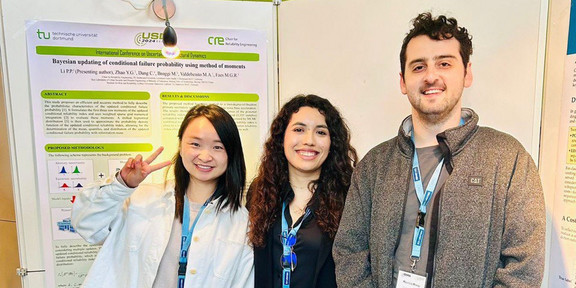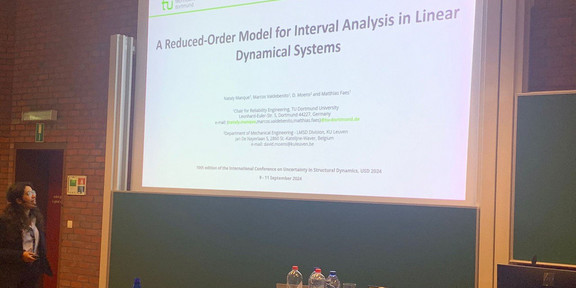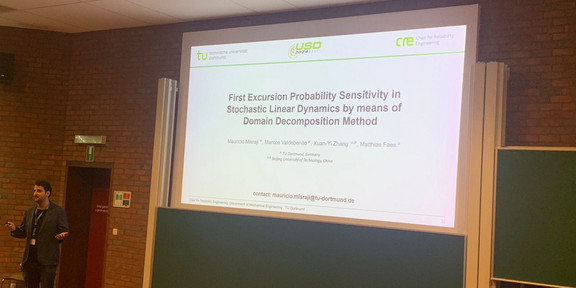CRE’s contributions to USD2024 conference



From September 9-11, 2024, members of the Chair for Reliability Engineering (CRE) participated in the 10th edition of the International Conference on Uncertainty in Structural Dynamics (USD2024), held in conjunction with ISMA2024 at KU Leuven, Belgium. Prof. Matthias Faes, Dr. Peipei Li, Nataly Manque Roa, and Mauricio Misraji represented the Chair and presented their research in the field of uncertainty modeling and structural dynamics.
USD2024 serves as a key platform for engineers, researchers, and professionals engaged in the modeling, analysis, testing, and enhancement of noise and vibration characteristics in mechanical, mechatronic systems, and civil structures. The conference emphasizes the integration of academic research with industrial innovation and applications.
Dr. Peipei Li’s Research:
Bayesian Updating of Conditional Failure Probability using Method of Moments
Abstract:
Bayesian updating reduces epistemic uncertainty for more reliable predictions, but characterizing the distribution of conditional failure probability with measurement data is complex. This study proposes an efficient and accurate method to fully describe the probabilistic characteristics of the updated conditional failure probability. It formulates the first three raw moments of the updated conditional reliability index and uses weighted sparse grid numerical integration to evaluate these moments. A shifted lognormal distribution is then used to approximate the probability density function of the updated conditional reliability index, allowing for the determination of the mean, quantiles, and distribution of the updated conditional failure probability with information reuse. An illustrative example was conducted to demonstrate the method's performance, with results compared against benchmarks from MCMC combined with MCS.
Nataly Manque Roa’s Research:
A Reduced-Order Model for Interval Analysis in Linear Dynamical Systems
Abstract:
Information about properties of linear dynamical systems is often unavailable as precise values. Instead, their characterization may be affected by imprecision, vagueness, ambiguity, or even incompleteness. In such a case, the system and its response are affected by epistemic uncertainty. To address this uncertainty, set-based methods such as interval analysis have been considered. Nevertheless, the associated numerical costs may increase considerably when interval methods are used. For dynamical systems, this numerical cost arises from the need for repeated eigenvalue/eigenvector analyses. Given this challenge, this paper proposes a framework for performing interval analysis for problems of linear elastic dynamics, considering a ReducedOrder Model (ROM). This ROM projects the dynamic equilibrium equations into a small-dimensional basis. This basis consists of a subset of the normalized modal shapes of the system obtained for crisp reference values associated with the interval quantities. The proposed strategy is tested in a truss structure.
Mauricio Misraji’s Research:
First Excursion Probability Sensitivity in Stochastic Linear Dynamics by means of Domain Decomposition Method
Abstract:
This contribution introduces a novel framework for the first excursion probability sensitivity estimation, applicable to linear dynamic systems subject to a Gaussian excitation. The proposed methodology is based on Domain Decomposition method, and the sensitivity estimator is calculated as the partial derivative of the first excursion probability with respect to a design parameter, such as the geometrical dimensions of the system. The linearity of the system plays a key role in building an efficient estimator. Domain Decomposition Method exploits this feature by exploring the failure domain in a very convenient way due to its special structure, characterized by the union of a large number of elementary linear failure domains. This approach allows the sensitivity estimator to be derived as a byproduct of the first excursion probability estimator. The effectiveness of this technique is demonstrated through a numerical example involving a large-scale model.
The conference provided an opportunity not only to present ongoing research but also to foster discussions on potential future collaborations. We look forward to developing these collaborations further in the coming years.



